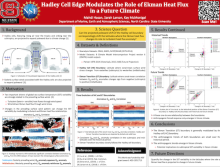Hadley Cell Edge Modulates the Role of Ekman Heat Flux in a Future Climate
Mahdi
Hasan
North Carolina State University
Poster
In a future climate, the Hadley cell and associated trade easterlies are projected to expand poleward. This projected change in the tropical atmospheric circulation and associated easterlies is expected to impact the ocean through changes in the mean sea surface temperature (SST). We also expect implications for large-scale SST variability, as the near-surface wind is directly related to two drivers of SST variability, that is, turbulent heat flux and anomalous wind-driven Ekman heat flux. Previous studies show that in the subtropics, anomalous turbulent and Ekman heat fluxes oppose each other, acting to reduce SST variability, whereas, in the midlatitudes, they reinforce each other and enhance SST variability. Through analysis of reanalysis products and CMIP6 model simulations, we find that the subtropical regions where the fluxes oppose each other are projected to expand poleward in a future climate, following the poleward expansion of the Hadley cell, with potential implications for the amplitude of subtropical SST variability. In historical simulations, a significant model uncertainty compared to the reanalysis results, particularly in the Northern Hemisphere, aligns with prior studies and can be attributed partly to internal climate variability. We use CESM2 model experiments to analyze the uncertainty associated with the internal variability on the Hadley cell boundary that projects onto the boundary where the role of Ekman changes.

Poster file
hasan-mahdi-confronting-poster.pdf
(3.8 MB)
